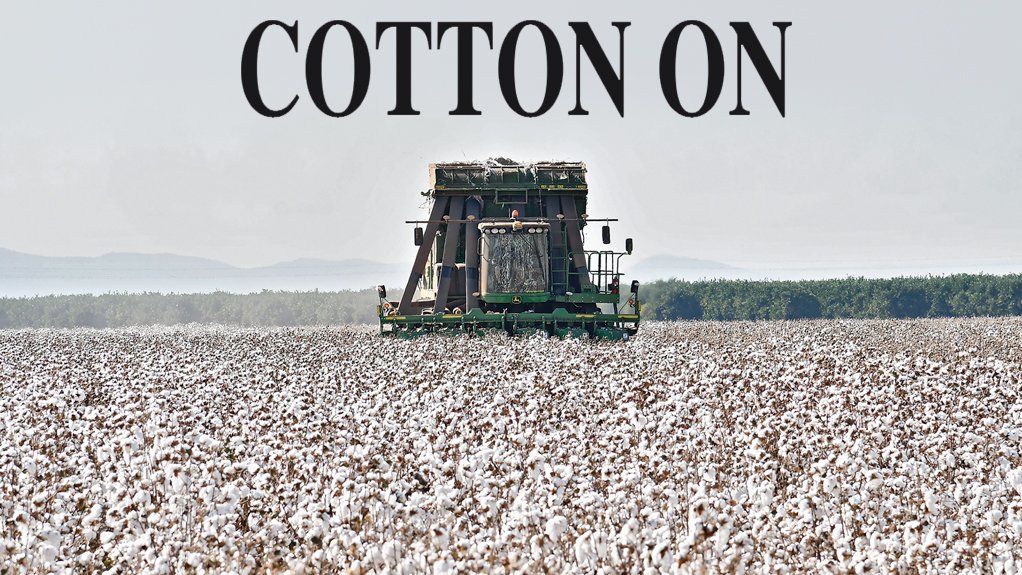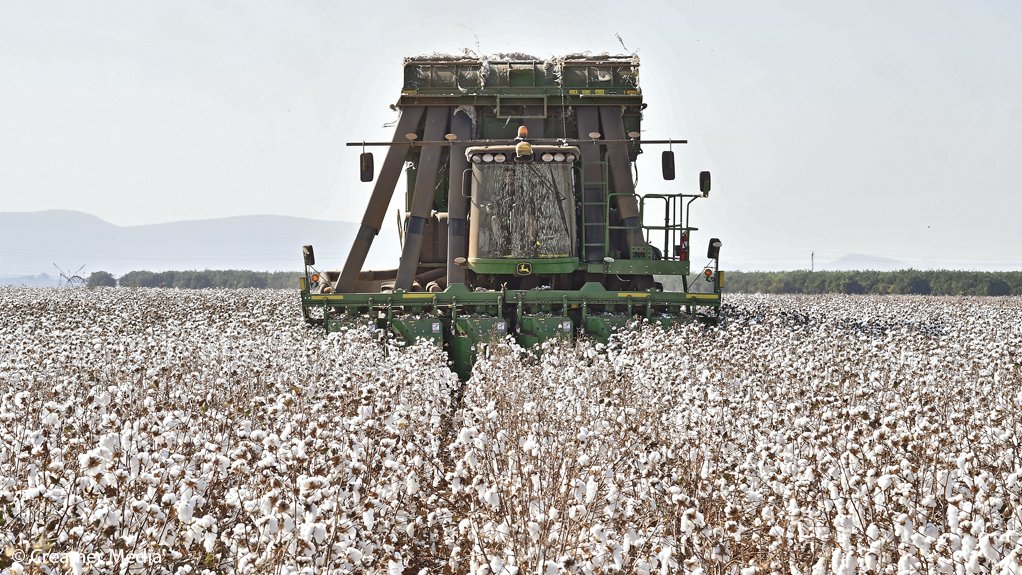Partnerships help pull domestic cotton industry out of doldrums



HOT COMMODITY Interest in farming cotton is increasing as prices and demand increase
Photo by Creamer Media's Dylan Slater
The South African cotton industry reached a crisis point in about 2013. With the industry on the verge of collapse, a series of events involving three seemingly unlikely role-players set off a chain reaction that resulted in a return to growth and substantial redevelopment for the sector into an expanding and rapidly thriving industry.
Cotton lint production has increased 800% since 2013, with production currently at about 244 543 lint bales (at 200 kg a bale, equalling 48 908 t in total) for the 2018/19 production year, an increase of 30% on the previous year.
In addition, dryland and irrigated crops planted during the 2018/19 season increased 45% and 22% respectively, as a result of more favourable cotton prices, as well as renewed interest in cotton farming.
Total hectares of dryland and irrigated cotton crops decreased to the lowest point in 2012/13, at 6 827 ha, but increased to 43 927 ha for this production year. Cotton industry forum Cotton South Africa (SA) states that some farmers who moved away from cotton during the tough times, and instead planted more profitable crops, such as sunflower, have started planting cotton seeds again to test yields and economic feasibility.
Lint sales totalled to R89-million in 2014, increasing to R792-million in March 2018, an increase of 790%.
Within the five years of renewed investment, industry turnover was R2.1-billion and government grants totalled R233-million, representing a return on investment of about 1 000%, according to Cotton SA.
As a result of this exponential growth, Cotton SA organised its inaugural Can’t Stop Cotton Industry Indaba earlier this month. The event was put together in partnership with the South African Sustainable Cotton Cluster (SASCC) – an offshoot of Cotton SA – to build capacity in the Southern Africa cotton industry value chain.
The SASCC programme was initiated to bring together the entire cotton value chain and related players, including the public sector, organised labour, consumer organisations, service providers and dedicated cluster management.
During Phase 1 of the SASCC programme, ginners invested R104-million of their own money. Farmers aligned with the cluster bought 11 cotton strippers and 27 cotton pickers (both are mechanised harvesters, similar to a combine harvester used for maize), also using their own money, to the value of R131-million.
A total of 1 265 small farmers were developed during this phase.
Last Gamble
The extent of the demise of the local cotton industry was so dire in 2013 that Cotton SA chairperson Leonard Venter received numerous calls from industry stakeholders to close down Cotton SA, as it was perceived as “the end of the road” for the industry.
He recalls how, in 2012, while driving in a state of dispare to meet with Loskop Cotton Gin CEO Joseph Kempen, he had a moment of inspiration. “When I arrived at Loskop Cotton Gin, I told Joseph that I was going to risk a last throw of the dice before I closed the whole pipeline. I then suggested establishing an oil press to extract oil from cotton seeds as a way of reattracting farmers to the production of cotton.”
Consultations between Venter and Cotton SA CEO Hennie Bruwer followed, after which Bruwer suggested a business plan be formulated. The authority to draw up the oil press business case landed on the desk of virtual value chain integration company OrganiMark Group founder and MD Heinrich Schultz.
Schultz highlighted the poor feasibility of investing in an oil press, and instead recommended forming a cotton cluster with the assistance of government. Subsequently, Schultz drew up a plan to revive the cotton industry value chain in Southern Africa and cofounded the Southern African Sustainable Textiles and Apparel Cluster in 2014.
Financial services company Absa Corporate and Investment Bank consumer goods and services sector head Isana Cordier explains the important role played by cotton: “Research carried out by the South African cotton industry for its Retail 2030 Masterplan reveals that 97.8% of fabric demand comes from the retail industry, 1.3% from industrial and 0.9% from public procurement. Of the total demand for fabric, 60% is derived from cotton.”
She points out that, if only 25% of the four major imported cotton products – T-shirts, towelling, chinos and underwear – were replaced by products manufactured in South Africa, as many as 37 000 jobs could be created and R5-billion injected into the local economy.
The SASCC has been lauded by Trade, Industry and Competition Minister Ebrahim Patel, who says the work it has undertaken in the past five years has been pivotal in establishing strong stakeholder partnerships across the supply chain, bringing together farmers, ginners, spinners, manufacturers and retailers into integrated supply chains.
He relayed government’s commitment to increasing investment in the retail, clothing, textile, footwear and leather value chain through the South Africa Investment Conference, held earlier this month. The conference showcased investor pledges totalling R363-billion in new investment in the local economy.
“At the investment conference, the country’s major retailers got together with manufacturers to sign the National Sector Master Plan for the retail, clothing, textile, footwear and leather value chain. The plan is being developed together with business, labour and government in the spirit of true partnership and renewal.”
Patel notes that the plan represents a bold vision for the entire retail and manufacturing value chain. “Every social partner has been asked to bring something concrete to the plan. Each of South Africa’s major retailers in the sector committed to increasing procurement of goods from South African manufacturers over the next decade.”
The aim is to increase local procurement from the current average of 44% to 65% by 2030.
As a result of commitments to the master plan, the Department of Trade, Industry & Competition foresees 120 000 additional jobs by 2030, with more than 70 000 of the jobs expected in the manufacturing sector.
“The master plan is already bearing fruit: retailers have committed in the first phase of implementation to new procurement, involving an additional 85-million units of clothing, footwear and textiles from local manufacturers. This commitment will create 28 000 new jobs over the next couple of years,” he notes.
Patel also says the SASCC has been an important anchor in changing the textile and clothing industry through the establishment of integrated supply chains, from farmer to retailer, representing the spirit of what the master plan is all about.
“We will continue to fly the flag for the South African cotton industry wherever we can, even on a global scale, so that we can open new markets beyond South African borders.”
Rebranded & Reloaded
The SASCC programme has created “great moments”, which need to be sustained, says Venter.
He attributes the success of the cluster largely to the commitment of cotton farmers, who have taken the “bold decision” to plant the cotton and invest in new technology, aligning themselves with cotton sustainability programme the Better Cotton Initiative and trusting the retailers to procure the committed tons.
“Private investments of more than half-a-billion rands were made by our farmers and ginners to grow this industry.”
Aligned to this growth and the commitment of retail partners, Cotton SA is once more able to grow its marketing initiative, Venter enthuses.
A major part of this marketing initiative includes the launching of a new green cotton mark to identify which products contain local cotton to help drive local demand. The new mark (which is similar to the old cotton mark, but green) was unveiled at the Can’t Stop Cotton Indaba.
“This mark will be our vehicle to grade and enhance the success of local cotton products,” Venter points out, adding that the new mark will help retailers build a local brand, which is also one of the master plan requirements.
Going forward, the SASCC plans to embark on Phase 2 of its strategy to reignite growth and ensure the sustainability of the local cotton industry.
The SASCC plans to address several concerns – including traceability and benchmarking, as, historically, there has been a lack of credible data – raised by various downstream role-players through Phase 2. The cluster also plans to tackle the prevalent silo mentality, which results in much duplication of work.
In terms of advancing cohesion between various role-players, the cluster also plans to focus on the implementation of successful projects to provide benchmarks on the achievement of, collaboration within and the development of partnerships. A roadmap is also earmarked for Phase 2, which will provide transparent and measurable goals, as well as action plans.
Article Enquiry
Email Article
Save Article
Feedback
To advertise email advertising@creamermedia.co.za or click here
Comments
Press Office
Announcements
What's On
Subscribe to improve your user experience...
Option 1 (equivalent of R125 a month):
Receive a weekly copy of Creamer Media's Engineering News & Mining Weekly magazine
(print copy for those in South Africa and e-magazine for those outside of South Africa)
Receive daily email newsletters
Access to full search results
Access archive of magazine back copies
Access to Projects in Progress
Access to ONE Research Report of your choice in PDF format
Option 2 (equivalent of R375 a month):
All benefits from Option 1
PLUS
Access to Creamer Media's Research Channel Africa for ALL Research Reports, in PDF format, on various industrial and mining sectors
including Electricity; Water; Energy Transition; Hydrogen; Roads, Rail and Ports; Coal; Gold; Platinum; Battery Metals; etc.
Already a subscriber?
Forgotten your password?
Receive weekly copy of Creamer Media's Engineering News & Mining Weekly magazine (print copy for those in South Africa and e-magazine for those outside of South Africa)
➕
Recieve daily email newsletters
➕
Access to full search results
➕
Access archive of magazine back copies
➕
Access to Projects in Progress
➕
Access to ONE Research Report of your choice in PDF format
RESEARCH CHANNEL AFRICA
R4500 (equivalent of R375 a month)
SUBSCRIBEAll benefits from Option 1
➕
Access to Creamer Media's Research Channel Africa for ALL Research Reports on various industrial and mining sectors, in PDF format, including on:
Electricity
➕
Water
➕
Energy Transition
➕
Hydrogen
➕
Roads, Rail and Ports
➕
Coal
➕
Gold
➕
Platinum
➕
Battery Metals
➕
etc.
Receive all benefits from Option 1 or Option 2 delivered to numerous people at your company
➕
Multiple User names and Passwords for simultaneous log-ins
➕
Intranet integration access to all in your organisation


















